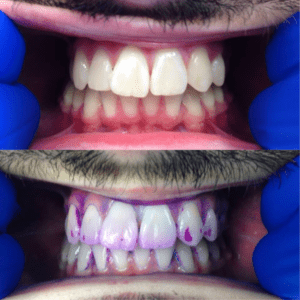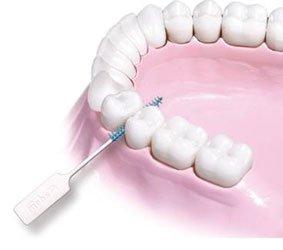When it comes to your regular home hygiene, our motto is “floss first.” But of course we know there are some folks who dislike flossing so much, they’ll opt to “forget first” and just brush their teeth instead.
Maybe it’s how the floss feels wrapped around their fingers. Maybe they don’t like sticking their fingers in their mouth. Maybe it’s because it makes their gums bleed – though that’s a big, glaring sign that flossing is something they really need to be doing. (Bleeding gums are an obvious symptom of gum disease.)
No doubt, there are probably as many excuses for not flossing as there are people who fail to floss.
 Regardless, you still need to clean between your teeth. After all, brushing only covers about 60% of their total surface area. Would you ever wash only 60% of your body in the shower and declare yourself squeaky clean?
Regardless, you still need to clean between your teeth. After all, brushing only covers about 60% of their total surface area. Would you ever wash only 60% of your body in the shower and declare yourself squeaky clean?
But while doing that might leave you a little smudgy or stinky, leaving nearly half your mouth uncleaned can have major health consequences, particularly in the form of periodontal disease. Bleeding gums are just the start. Science continues to show that gum disease is a risk factor for a wide range of inflammatory conditions, including heart disease, stroke, diabetes, Alzheimer’s, cancer and more.
Bottom line: If you want to be healthy, you’ve got to clean between your teeth. Fortunately for the floss-haters, there are other tools you can use. In some cases, the alternative may actually be even more effective than floss.
Earlier this spring, a research review in the Journal of Clinical Periodontology found that while all interdental cleaning methods appear to reduce gingivitis (early gum disease), when it comes to removing plaque, interdental (or interproximal or “proxy”) brushes are best.
Weak evidence of unclear or small magnitude was retrieved that supported dental floss, woodsticks and the oral irrigator to reduce gingivitis in addition to toothbrushing. No concomitant evidence for an effect on plaque emerged. There is moderate evidence that IDBs [interdental brushes] in combination with toothbrushing reduce both plaque and gingivitis.
 These small, round brushes come in different sizes and are designed to slip comfortably between the teeth. This lets you easily clean their sides, as well as at the gumline and top of the sulcus – the little gap between tooth and gum that gets deeper as periodontal disease progresses, creating little “pockets.” Those pockets become perfect harbors for bacteria and other oral pathogens: dark, moist and less exposed to oxygen. Under those conditions, pathogens can really proliferate.
These small, round brushes come in different sizes and are designed to slip comfortably between the teeth. This lets you easily clean their sides, as well as at the gumline and top of the sulcus – the little gap between tooth and gum that gets deeper as periodontal disease progresses, creating little “pockets.” Those pockets become perfect harbors for bacteria and other oral pathogens: dark, moist and less exposed to oxygen. Under those conditions, pathogens can really proliferate.
Interestingly, an earlier research review found that those pockets were reduced much more with proxy brush use than with floss. And while the authors found that evidence of their effect on gingival inflammation was “less conclusive,” they did find that interdental brushes did a better job than floss when it came to removing plaque.
The main thing, though, is – again – regularly cleaning between your teeth, as well as the surfaces that show, whether with a proxy brush or floss, woodstick or oral irrigator. Should you like to give proxy brushes a try, you can find them in the oral health and hygiene section of most large drugstores, or you can order them online.
Here’s how to use them :
Want to add a little extra antimicrobial power? Try dipping the tip into an herbal medicament such as the Dental Herb Company’s Tooth and Gums Tonic or Under the Gums Irrigant before you brush. The essential oils in these products help keep pathogens in check, while additional herbs support the rebuilding of healthy connective tissue.
Top image by Ajeverett, via Wikimedia Commons